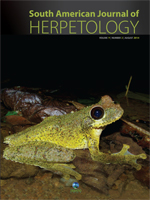The frogs of the family Ceratophryidae (comprised of three genera containing 12 species) are well known for their voracious feeding behavior and unique morphologies in both larval and post-metamorphic life stages. Nevertheless, relatively little is known about the diet of these species, especially in nature. We summarized the current knowledge of the diet of larval and post-metamorphic ceratophryids in both natural and experimental settings by conducting a literature review, specimen dissections, and field observations. Prior to this study, diet information did not exist for one fourth of the species in the family: Ceratophrys calcarata, Ceratophrys joazeirensis Ceratophrys stolzmanni, and Ceratophrys testudo. We add, for the first time, information on the diet of Ceratophrys calcarata. In addition, our survey revealed that relatively few detailed studies with large sample sizes have been conducted on the diet of these frogs. Frequently, knowledge of the diet of a species is derived from palatability experiments using captive individuals (often a single individual). From those diet studies that were conducted under natural conditions, ceratophryids can be classified as generalist, opportunistic predators, often preying on a wide variety of invertebrate and vertebrate prey. All species of ceratophryids for which we obtained information on diet were found to consume vertebrates, with anuran prey occurring in nearly all species. Even less is known about the diet of the tadpoles of these species; while cannibalism is assumed to be widespread, we found evidence for cannibalism at the larval stage in only three species. Future studies should attempt to understand the trophic ecology of these species under natural scenarios at both life stages, and an ontogenetic approach using individuals across multiple size classes could elucidate the niche shifts associated with these species from larva to adult.
How to translate text using browser tools
1 August 2014
On the Diet of the Frogs of the Ceratophryidae: Synopsis and New Contributions
Christopher M. Schalk,
Carmen G. Montaña,
Jaimie L. Klemish,
Erik R. Wild
ACCESS THE FULL ARTICLE





